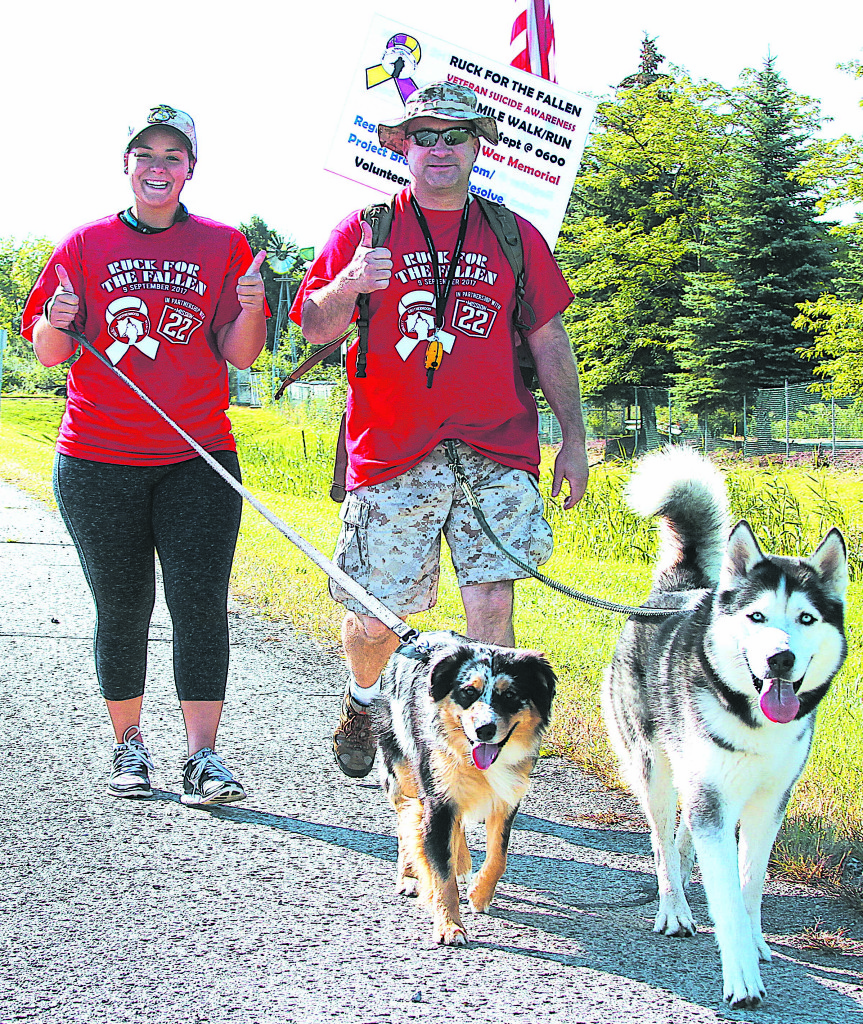
Mile after mile, hour after hour, they walked and walked.
They walked to give veterans hope.
They walked to give veterans homes.
They walked to show veterans they’re neither alone nor forgotten.
Folks were seen hiking along M-24 through Oxford Saturday morning as part of the Second Annual Ruck for the Fallen. The 23-mile walk began at the Orion Veterans Memorial and ended at VFW Post 4139 in Lapeer.
The event was designed to raise awareness and funds for Project Brotherhood Resolve (PBR). The walk grossed approximately $8,000.
Founded in 2016, PBR’s mission is to address the problems of homelessness and suicide in the veteran community through intervention.
“We’re still working on (securing) our nonprofit status,” said founder and CEO Joseph Gemayel, 35, of Hadley Township.
Gemayel explained the first 22 miles of the Ruck for the Fallen were walked in honor of the 22 veterans who die from suicide each day.
“The last mile is for . . . the people that continue to push through their troubles, through their demons, through their tribulations and live on,” said Gemayel, a member of the Illinois National Guard for 16 years.
Seventy-two walked the M-24 route, while one ran it. The runner, Kim Giyomory, finished the 23 miles in 5 hours, 13 minutes. The fastest walker was Rena Rarick, who completed the full route in 7 hours, 3 minutes. The oldest person to finish was Lewis Robinson, 68, while the youngest was Bella Droste, 12.
Participants in the Ruck for the Fallen were invited, but not mandated, to carry 22-pound rucksacks as another symbolic gesture.
“We let people carry what they want to carry, what they can carry. We don’t measure,” explained Gemayel, who has been deployed to Iraq twice and Afghanistan once since joining the National Guard at age 19. “We had a gentleman carry a 75-pound rucksack. We had people carrying a 10-pound rucksack. We had people carrying no rucksack.”
It should be noted the 22-veterans-per-day suicide rate is an oft-cited figure that’s based on incomplete data.
The U.S. Dept. of Veterans Affairs (VA) did a more comprehensive analysis of veteran suicide and released the results in July 2016.
That report – which examined more than 50 million veteran records, from 1979 to 2014, in all 50 states – found that in 2014, an average of 20 veterans died from suicide each day and, of those, six were users of VA services. It also found that in 2014, veterans accounted for 18 percent of all suicide deaths among U.S. adults despite constituting 8.5 percent of the population.
In Gemayel’s opinion, there needs to be more done in terms of offering different treatment options to veterans struggling with serious conditions, such as Post-Traumatic Stress Disorder (PTSD), that can lead to suicide. He doesn’t believe relying heavily on prescription drugs adequately addresses the problem.
“People respond to medications in different ways,” he said. “I’m not saying that they don’t work, but they don’t work (for) everybody.”
As for homelessness among veterans, according to a Point-in-Time (PIT) Count conducted by the U.S. Department of Housing and Urban Development on a single night in January 2016, there were 39,471 veterans identified as experiencing homelessness throughout the nation.
Of those, 13,067 were counted as unsheltered, which means they were living on the street or in a place not meant for human habitation. The remaining 26,404 had shelter via emergency shelters and transitional housing. In Michigan, there were 758 sheltered veterans and 64 unsheltered veterans during the 2016 PIT Count.
Gemayel’s vision for PBR is to someday buy a large piece of property to give homeless veterans a safe place to live for as long as they need to overcome their issues and begin rebuilding their lives.
“It would be a long-term housing solution for veterans,” he said. “There’s a lot of programs that limit you to a year (or) two years . . . (but) we all recover at a different rate. When you put a timeline on somebody’s recovery, you’re rushing it, you’re not doing it right. Time heals all wounds is what they say.”
“I wouldn’t call it temporary (housing) because there’s always going to be a few vets that aren’t going to recover enough to go back out into the world,” Gemayel noted.
Gemayel would like the property to do more than provide housing. He’d like it to operate as a farm, where food is grown and animals are raised. He envisions the crops feeding the veterans and being sold at local farmer’s markets.
“We want to be self-sufficient,” Gemayel said.
Veterans would work the farm and develop skills to help them get back on their feet and reintegrate into society “when they feel comfortable.”
For more information about PBR, please visit www.projectbrotherhoodresolve.org.

Leave a Reply